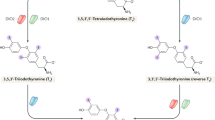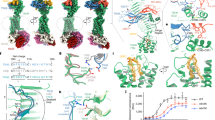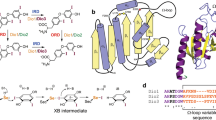Abstract
PHENOBARBITAL given to rats in doses known to increase the formation of hepatic smooth endoplasmic reticulum (SER) and drug-metabolizing enzymes also increases hepatocellular binding of thyroxine (T4)1 and its deiodinative and biliary clearance2. Subcellular fractionation of liver homogenates suggested that the increased hepatocellular binding could be attributed to the microsomal membranes3. Because hepatic microsomes contain a specific iodothyronine deiodinase4–7, we attempted to determine whether the increased deiodination observed in vivo could be related to increased microsomal activity.
This is a preview of subscription content, access via your institution
Access options
Subscribe to this journal
Receive 51 print issues and online access
$199.00 per year
only $3.90 per issue
Buy this article
- Purchase on Springer Link
- Instant access to full article PDF
Prices may be subject to local taxes which are calculated during checkout
Similar content being viewed by others
References
Bernstein, G., Artz, S. A., Hasen, J., and Oppenheimer, J. H., Endocrinology, 82, 406 (1968).
Hasen, J., Bernstein, G., Volpert, E., and Oppenheimer, J. H., Endocrinology, 82, 37 (1968).
Oppenheimer, J. H., Bernstein, G., and Surks, M. I., J. Clin. Invest., 47, 1399 (1968).
Schwartz, H. L., Bernstein, G., and Oppenheimer, J. H., Endocrinology, 84, 270 (1969).
Stanbury, J. B., Morris, M. L., Corrigan, H. J., and Lassiter, W. E., Endocrinology, 67, 353 (1960).
Wynn, J., Gibbs, R., and Royster, B., J. Biol. Chem., 237, 1892 (1962).
Nakagawa, S., and Ruegemar, W. R., Biochemistry., 6, 1249 (1967).
Schneider, W. C., and Hogeboom, G. H., J. Nat. Cancer Inst., 10, 969 (1950).
Lowery, O. A., Rosenbrough, N. J., Farr, A. L., and Randall, R. J., J. Biol. Chem., 193, 265 (1951).
Berson, S. A., and Yalow, R., Ann. NY Acad. Sci., 70, 56 (1957).
Tata, J. R., Biochim. Biophys. Acta, 35, 567 (1959).
Morreale de Escobar, G., Escobar del Rey, F., and Rodriguez, P. L., J. Biol. Chem., 237, 2041 (1962).
Greenwood, F. G., Hunter, W. H., and Glover, J., Biochem. J., 89, 114 (1963).
Stanbury, J. B., J. Biol. Chem., 228, 801 (1957).
Remer, H., and Merker, H. J., Science, 142, 1657 (1962).
Fouts, J. R., and Rogers, L. A., J. Pharmacol. Exp. Therap., 147, 1112 (1965).
Author information
Authors and Affiliations
Rights and permissions
About this article
Cite this article
SCHWARTZ, H., KOZYREFF, V., SURKS, M. et al. Increased Deiodination of L-Thyroxine and L-Triiodothyronine by Liver Microsomes from Rats treated with Phenobarbital. Nature 221, 1262–1263 (1969). https://doi.org/10.1038/2211262a0
Received:
Revised:
Published:
Issue Date:
DOI: https://doi.org/10.1038/2211262a0
This article is cited by
-
Einflu� von Phenobarbital auf die Schilddr�senfunktion bei Wistar-und Gunnratten
Zeitschrift f�r Kinderheilkunde (1972)
Comments
By submitting a comment you agree to abide by our Terms and Community Guidelines. If you find something abusive or that does not comply with our terms or guidelines please flag it as inappropriate.



